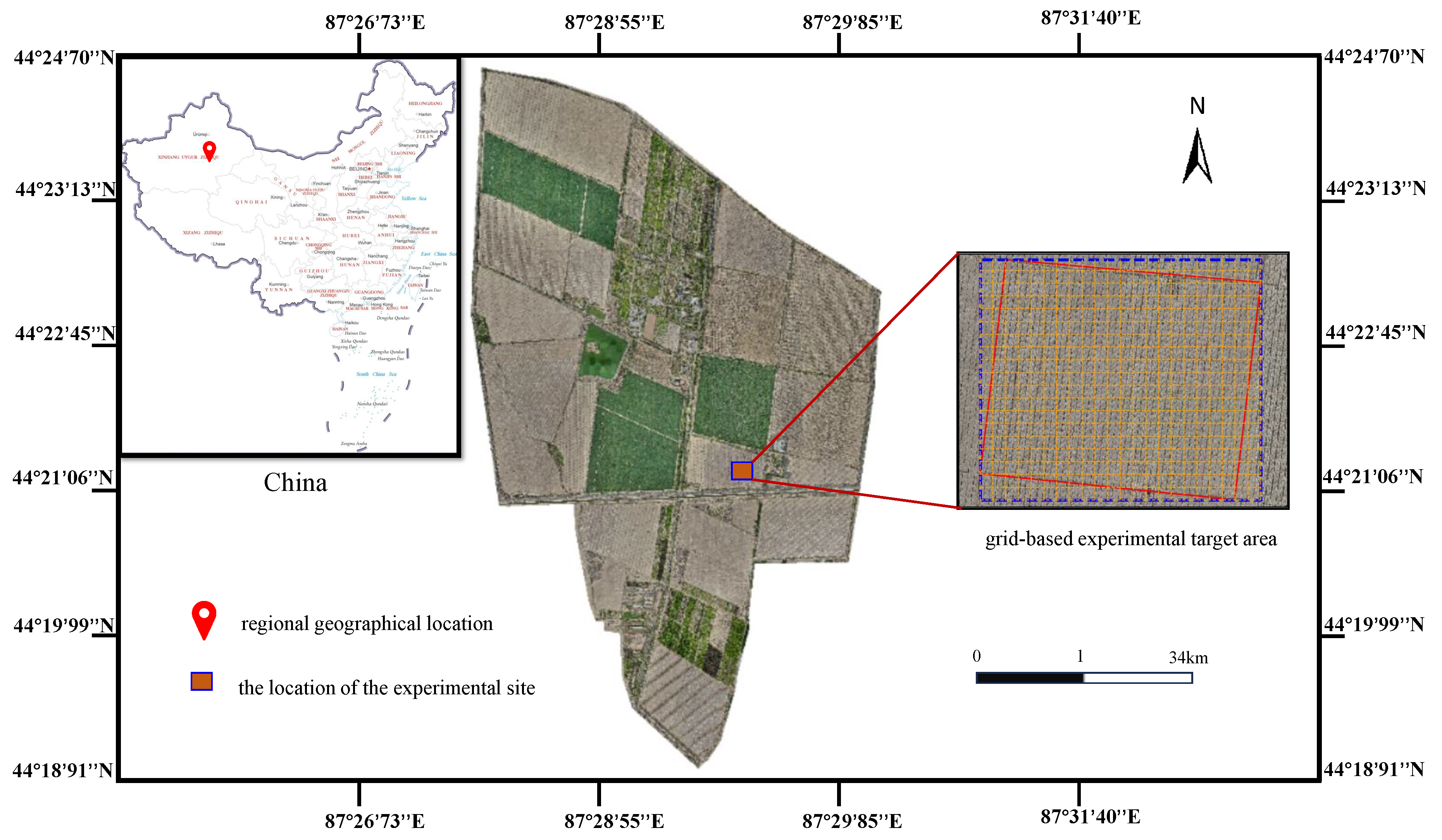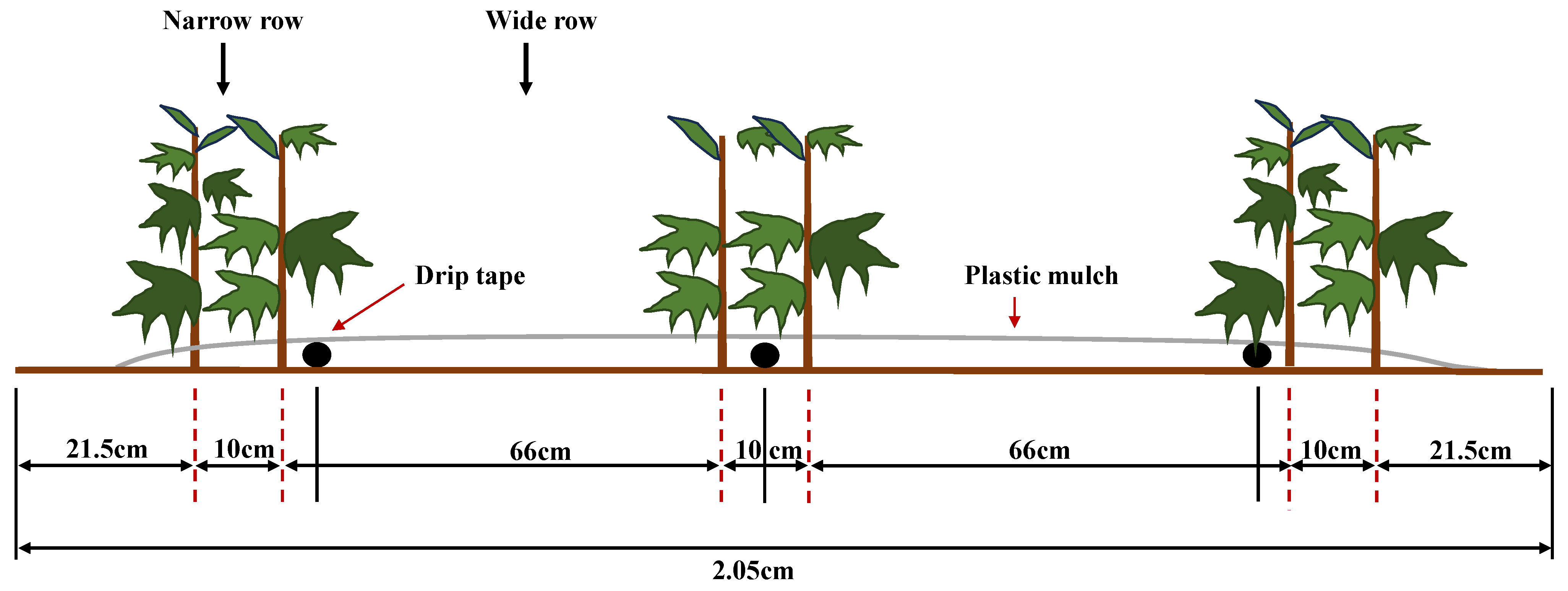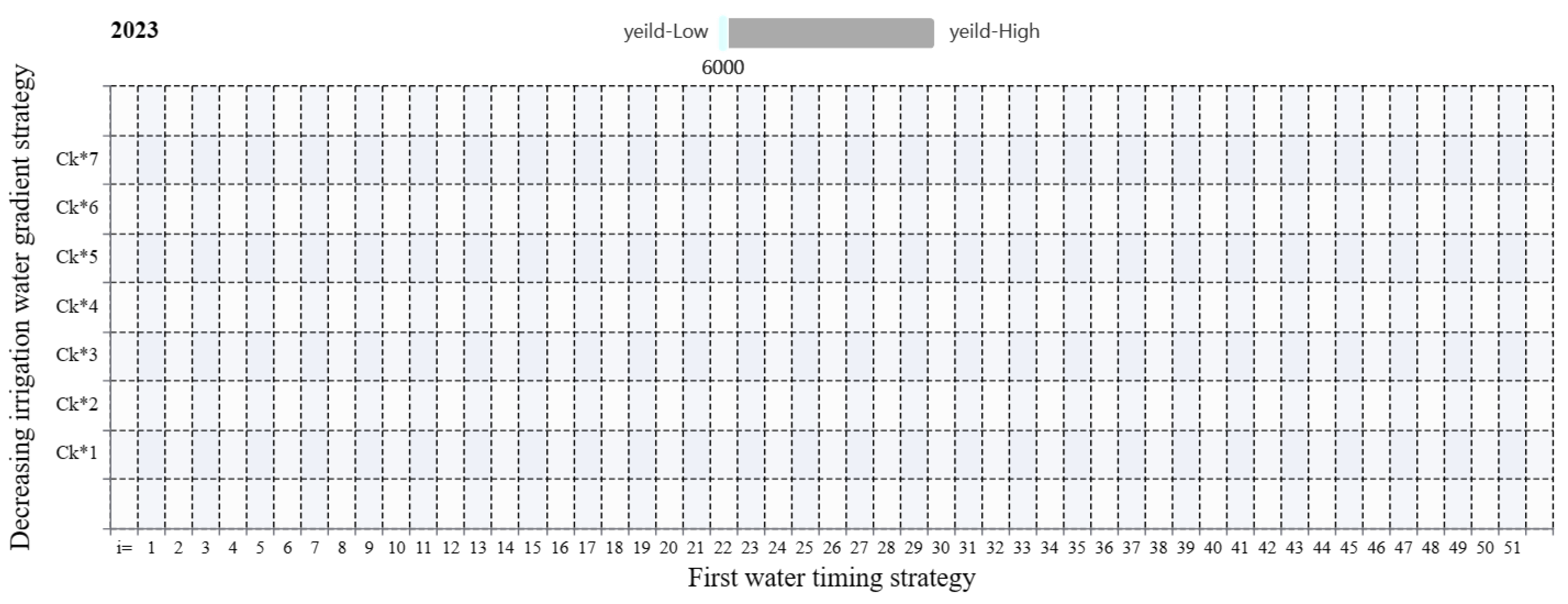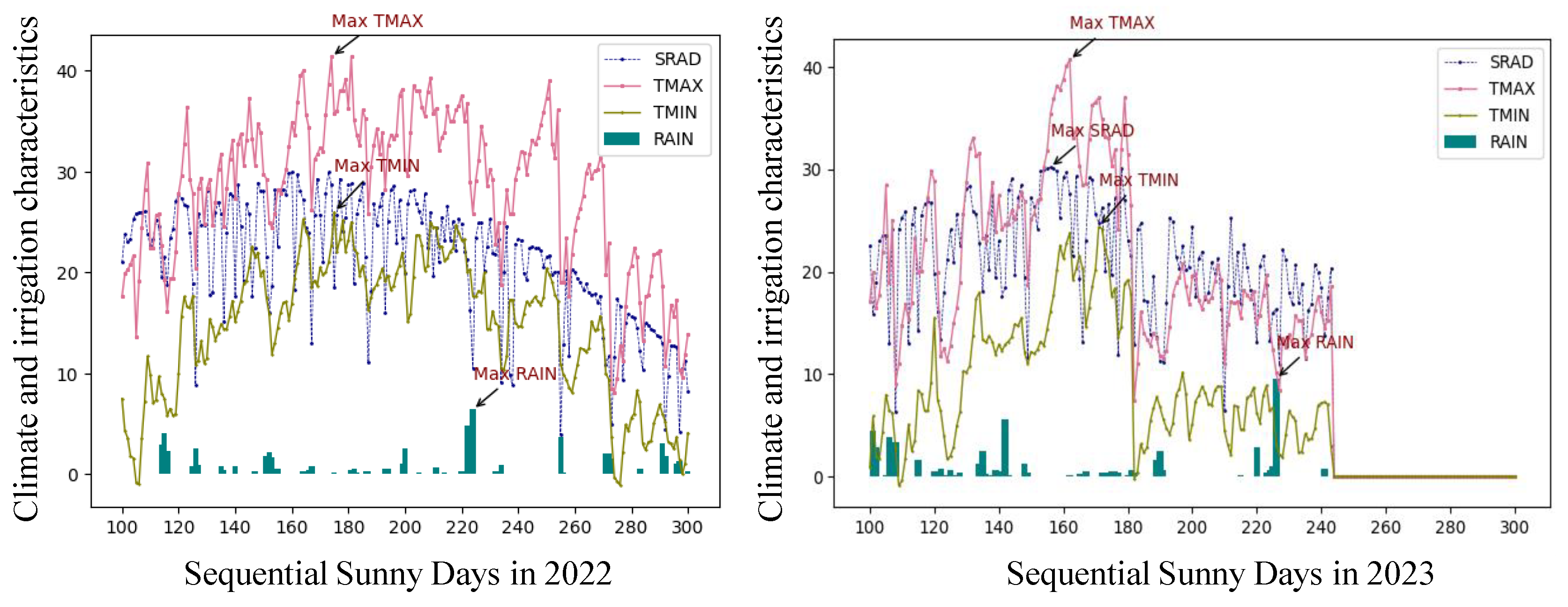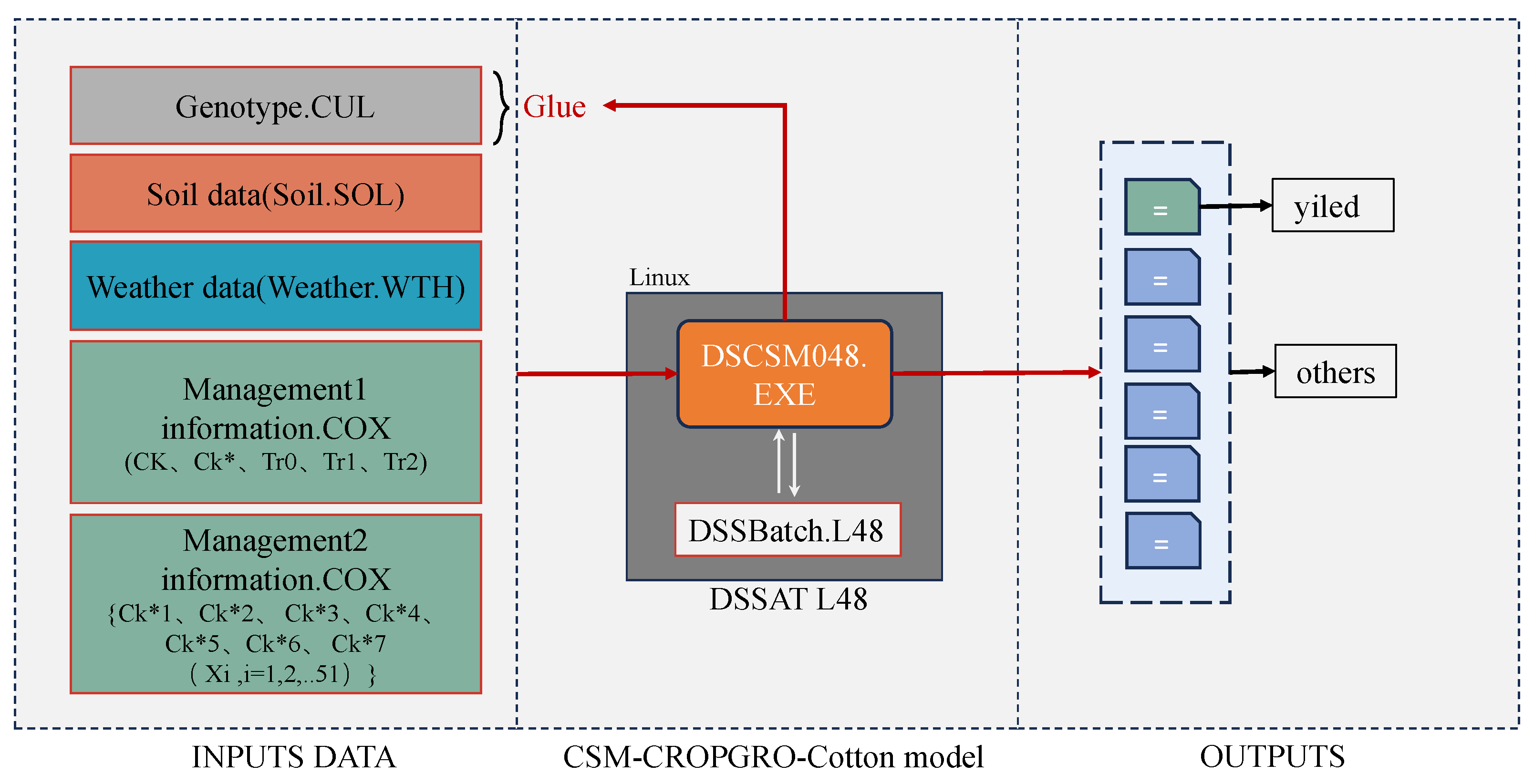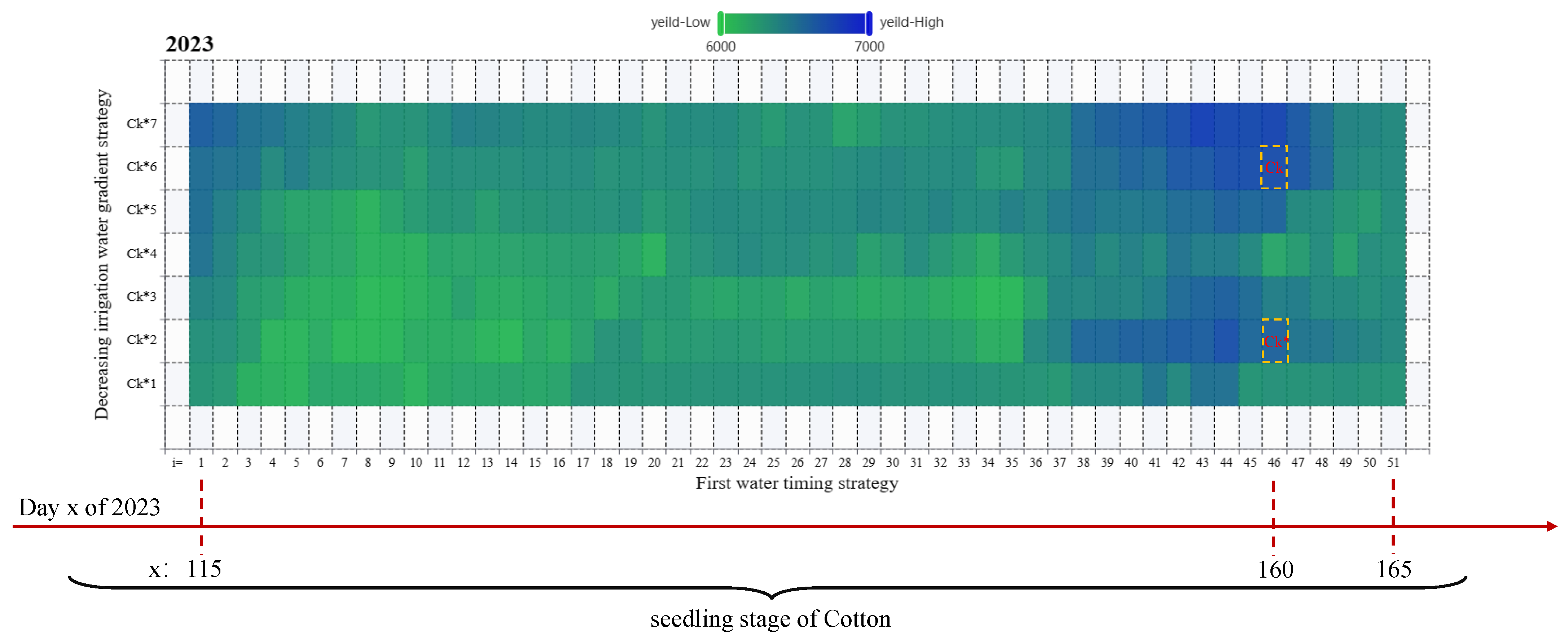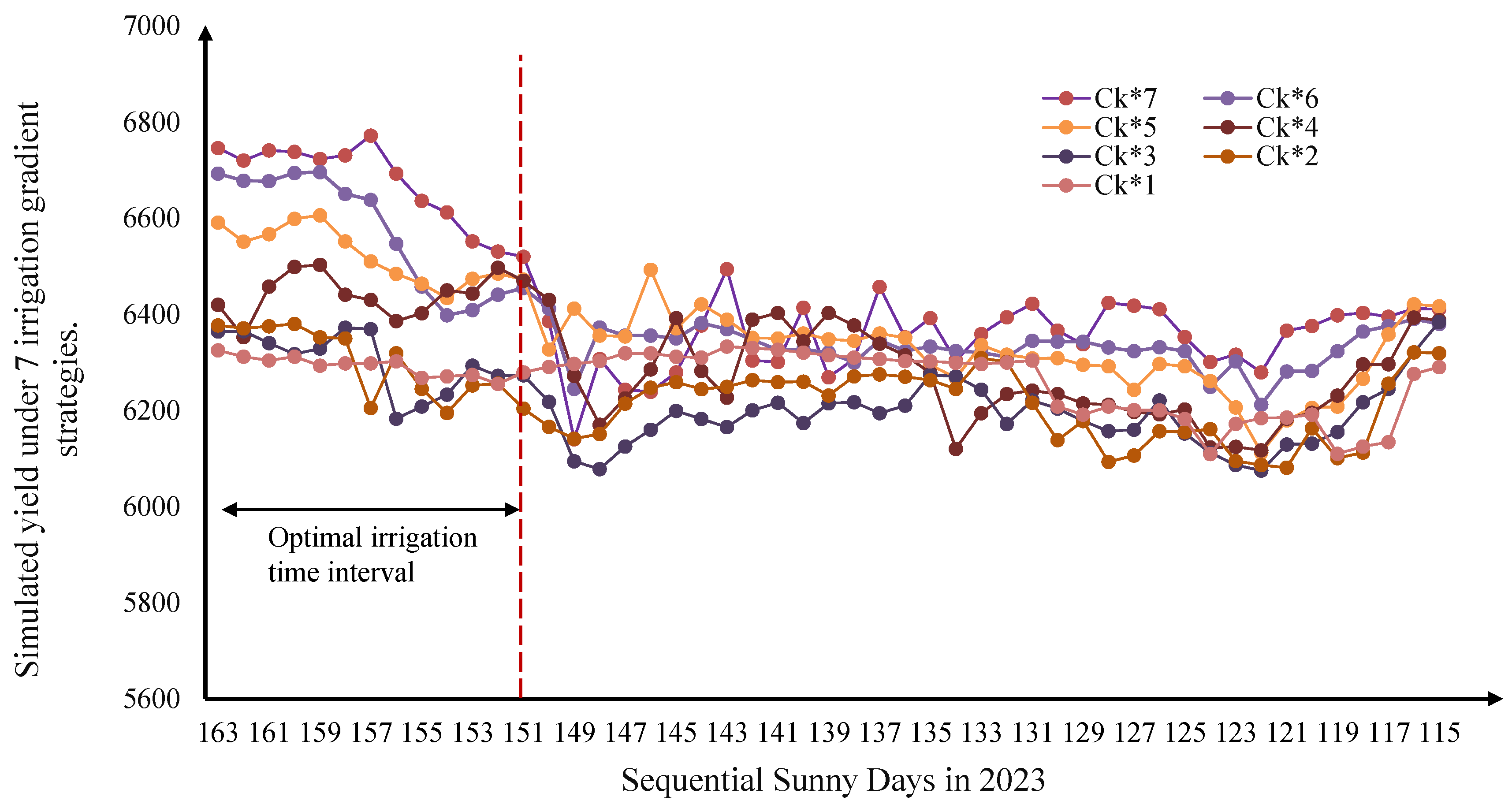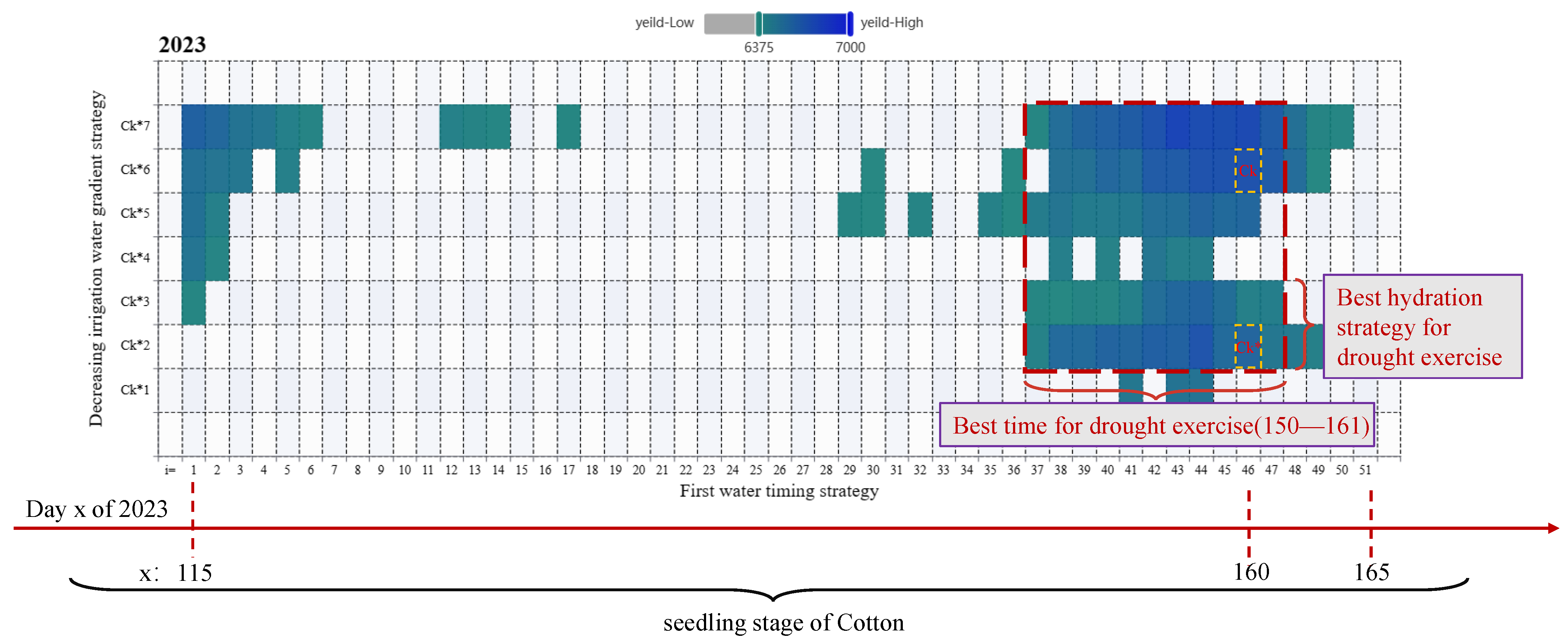1. Introduction
Cotton is one of the most important fiber crops for the textile and garment industry [
1]. The climate and land conditions in Changji provide unique advantages for large-scale mechanized cotton cultivation. However, in recent years, global climate change and increasing water resource pressure have had a significant impact on the cotton industry [
2,
3]. Internationally, cotton cultivation techniques have developed significantly, with various innovative and advanced cultivation methods emerging. These techniques include precision irrigation, remote sensing monitoring, genetic improvement, and soil conservation to enhance cotton yield and quality while reducing water resource requirements [
4,
5,
6,
7,
8,
9]. Applying these cutting-edge technologies provides new opportunities and challenges for cotton cultivation. However, despite these achievements, industry leaders anticipate that climate change and variability, particularly drought and high temperatures, could reduce crop yields by approximately 50% [
10,
11]. A significant challenge in cotton farming is adapting to arid and water-deficient conditions [
12]. Drought significantly influences cotton growth and development, severely affecting both yield and quality. Hence, water-deficient irrigation strategies have become a focal point of research, aiming to optimize water resource utilization and mitigate the adverse effects of drought on cotton.
Drought stress is a nonbiological stress that poses significant challenges to agricultural productivity every year. Some techniques to alleviate drought stress include mulching, drought-tolerant plant varieties, super-absorbent hydrogels, and biochar. However, most of these practices are labor-intensive, costly, and have limited effectiveness. It has been demonstrated that inducing plant root growth through irrigation strategies is a prioritized approach that encompasses numerous direct and indirect benefits [
13]. The periodic recurrence of drought makes the design of technologies for mitigating drought stress highly important. Recent methods for alleviating drought stress include film planting [
14], the development of drought-tolerant crops [
15], the use of nanoparticles for drought tolerance [
16], and the application of super-absorbent hydrogels and biochar [
17,
18], as well as harnessing rhizobacteria that promote plant growth [
19].
However, the effectiveness of these practices in mitigating drought stress is limited. Instead, a more easily implementable approach is to induce plants with drought resistance through deficit irrigation. Research on deficit irrigation in crops has been conducted internationally since the 1970s, primarily focusing on fruit trees [
20]. In the 1980s, the emphasis of deficit irrigation research shifted towards water-saving and yield-increasing effects, as well as mechanisms and fruit quality issues. Scholars have conducted extensive studies on the physiological and biochemical responses of crops under deficit irrigation, water requirement patterns, optimal timing, and degree of deficit [
21]. From the 1990s to the present, the focus of deficit irrigation research has shifted from yield improvement to quality enhancement [
22] and has expanded to aspects such as fertilizer utilization efficiency under deficit irrigation. Additionally, during the early and middle stages of pear fruit growth, the implementation of deficit irrigation by Cheng Fuhou et al. significantly reduced the fruit shape index. During the water-controlled treatment, the fruit’s water content was significantly lower than the control, but it did not inhibit fruit growth or affect fruit size. On the contrary, there was a tendency for increased yield, individual fruit weight, fruit quality, and storage stability [
23]. Zeng Dechao and others have conducted research on deficit irrigation in fruit trees, but the research content mainly focused on irrigation techniques [
24]. Meng Zhaojiang conducted deficit irrigation experiments on summer maize, Zhang Xiying and others conducted field experiments on deficit irrigation regimes for winter wheat [
25,
26], Wang Mixia and others conducted deficit irrigation experiments on field mulched corn [
27], and Hu Xiaotao and others extended deficit irrigation research to maize as a cereal crop, studying the effects of deficit irrigation on maize physiological indicators and water use efficiency [
28]. Other studies mainly focused on theoretical issues related to inadequate irrigation under water scarcity conditions [
29].
This study implemented deficit irrigation on cotton to induce drought tolerance and enhance its drought resistance. In order to identify the most suitable timing and amount of deficit irrigation, the study utilized weather and soil sensor data collected from experimental sites and employed crop model batch-processing techniques to conduct simulation experiments. Prior to the experiments, the model was calibrated. When compared to traditional field experiments with control groups, this approach offers more certainty and convenience in determining the induction of drought tolerance in cotton.
The experimental site is located in the heartland of the Eurasian continent, characterized by abundant sunlight, rich thermal energy, scarce precipitation, and dry air. It is a typical inland arid and semi-arid region. The vast land resources, abundant solar radiation, and relatively stable precipitation and glacial meltwater provide excellent natural conditions for cotton cultivation in the area. However, the region’s arid and low rainfall characteristics, coupled with intense evaporation, make oasis irrigation agriculture the predominant form of agriculture. Irrigation plays a vital role in cotton production in Xinjiang. In recent years, the increasing cultivation area and agricultural water use in Changji, combined with issues such as excessive groundwater extraction and competition for water resources between agriculture and ecosystems, have become increasingly prominent. These problems constrain the sustainable production of cotton [
30]. Scientific and rational irrigation management and technological measures can enhance cotton’s ability to adapt to arid environments [
31]. In order to overcome the adverse impacts of drought on cotton cultivation, measures for drought induction have become an important research direction. Drought induction involves implementing appropriate water management and other agronomic measures to enhance plants’ ability to adapt to drought [
32]. These measures can improve cotton’s physiological characteristics and drought resistance, thereby enhancing yield and quality [
33]. Exploring strategies that are suitable for drought induction is significant for enhancing drought resistance and promoting the sustainable development of cotton cultivation. Finally, mitigating the climate drought and water scarcity challenges faced in cotton production in Xinjiang requires the widespread adoption of water-saving irrigation techniques and improved water resource utilization efficiency [
34]. Different growth stages of cotton plants exhibit varying sensitivities to water stress. Adequate irrigation should be provided during critical periods of crop water demand while reducing irrigation during less sensitive stages. This approach holds significant application potential in cotton production in Xinjiang. It is crucial for achieving sustainable cotton production, maintaining the economic income of local cotton farmers, and contributing to global cotton production [
35].
3. Results and Discussion
3.1. Yield and LAI Simulation Results and Analysis
Before conducting the simulated experiments for drought hardening, it was necessary to validate the accuracy of the DSSAT model. This study performed a calibration of the genetic parameters using historical data from Changji. Then, it used the yield and leaf area index (
) data from 2023 to verify the accuracy of the model [
50]. The yield of the five field experiments under deficit irrigation was measured through sampling on October 1st, and the simulated yields for different treatments were obtained using the calibrated DSSAT model. The measured and simulated yields per mu for different treatments are shown in
Table 8. The observed LAI values for the five field experiments were collected and calculated at different time points from July to August, and the simulated values were obtained from the DSSAT simulation.
Table 9 presents the LAI data for different strategies.
Figure 7 and
Figure 8 show the trends of LAI during the cotton growth process for treatment Ck and treatment Ck*, respectively. It can be observed from
Figure 8 that the trend in LAI closely matches the observed LAI data.
Based on the above data, the calculated for yield is 208, is 0.139, is 0.029, is 0.856, and d is 0.0616. The results, with , , and , indicate that the model simulation results are good. Similarly, the values of d for the simulated and observed leaf area index (LAI) for several experiments are greater than 65%, and is greater than 80%. The values of , , and d demonstrate good robustness when validating the CSM-CROPGRO-Cotton model, indicating its suitability for cotton simulation experiments. Therefore, it can be concluded that the DSSAT model with calibrated parameters can be used for yield prediction in the Huaxing area of Changji.
The yield trend analysis in
Figure 7 reveals that the difference between treatments Ck and Ck* lies in reducing the amount of irrigation of the first water in Ck* while advancing the timing of the first irrigation to the early stage of the seedling period. However, the results are astonishing: despite significantly reducing the amount of irrigation of the first water and irrigating the cotton earlier, the yield remains close to that of the higher irrigation amount without advancing the timing of the first irrigation. This pattern has significant implications for water-saving benefits in arid and water-deficient regions.
Through monitoring the growth and final yield performance of the seedlings in real field experiments, we found that cotton plants exhibit a resilience to mild drought during the seedling stage. By observing the control experiments in the field, it was determined that when seedlings undergo continuous growth under drought conditions within a certain duration, their yield does not suffer significant damage. However, if the seedlings experience prolonged or more severe drought stress, their growth and yield are significantly negatively affected.
3.2. Simulation Results and Analysis of Drought Hardening
The yield trend analysis in the field experiments found that reducing the amount of irrigation of the first water can provide cotton with a certain stress-tolerance effect. This indicates that appropriate drought hardening can be helpful for water-saving and yield protection in cotton. In order to further explore the patterns of drought hardening, this study conducted the simulation and modeling of 357 irrigation strategies according to the experimental design in
Section 2.3. The simulated yields were represented using a heatmap distribution in a constructed Cartesian co-ordinate system. The vertical axis represents seven different irrigation treatments: Ck*1, Ck*2, Ck*3, Ck*4, Ck*5, Ck*6, and Ck*7, with detailed data shown in
Table 3. The horizontal axis represents the selectable time series for the first water irrigation, ranging from the 115th day to the 165th day of 2023, covering the entire cotton seedling growth stage. The grid formed by the intersection of the vertical and horizontal axes represents different combinations of irrigation strategies, totaling 357. The study used a calibrated crop model to simulate the 357 strategies, resulting in 357 different simulated yields. The corresponding yield values were mapped using colors ranging from light to dark, as shown in
Figure 9. The strategy represented by the orange dashed box corresponds to Ck and Ck*, with similar yields.
In this study, we conducted a combination of real field experiments and simulation experiments to investigate the response and adaptability of cotton plants to drought stress during the seedling stage. The real field experiments, which were based on monitoring the growth and final yield performance of the seedlings, revealed that cotton plants exhibit resilience to mild drought during the seedling stage. On the other hand, the results of the simulation experiments indicated that cotton seedlings can generally maintain normal growth and yield under mild water deficiency conditions. In the simulation experiments involving 357 irrigation strategies, gradually reducing the amount of irrigation could guide the plants to adapt to water scarcity. By gradually decreasing the amount of irrigation, we allowed the plants to gradually adapt to a lower water supply over a period of time, thereby enhancing their drought tolerance. Additionally, we simulated different water supply conditions under drought by adjusting the irrigation interval. Ultimately, we found that longer irrigation intervals can improve the plants’ adaptability to drought stress.
From
Figure 9, it can be visually observed that the yield distribution under different strategies, from a horizontal time sequence perspective, shows that the yields are significantly higher within the range of “Day 150” to “Day 161” of the solar calendar compared to other times. There is also a slight increase in yields around “Day 115”. This pattern is consistent with the trend shown in the line chart
Figure 10, where each point on the line corresponds to 1 of the 357 strategies. Therefore, it can be concluded that while maintaining relatively small yield fluctuations, the permissible irrigation time range for the first water is from Day 150 to Day 161 of 2023, specifically from 25 June to 6 July. It also indicates that “Day 115” falls within the “seedling water” irrigation time range. Conducting the first water irrigation during this period can effectively maintain higher yields.
Figure 9 presents irrigation strategies, with the “first amount of irrigation” as a variable, where the quantity and timing of the first irrigation directly influence the crop’s growth and development stages. Excessive irrigation quantity or delayed timing may subject the crops to water stress, resulting in hindered growth and reduced yields. Conversely, insufficient irrigation quantity or early timing may fail to meet the crop’s water requirements, thereby affecting normal growth and development. In this experiment, the quantity and timing of the first irrigation were systematically adjusted during simulations to find the optimal amount of irrigation and timing for maximizing yields. The simulations simulated the growth status of cotton under different conditions, considering the effects of drought stress. Adjusting the quantity and timing of the first irrigation directly impacted the yield and water use efficiency. When the irrigation period fell within the range of “Day 150” to “Day 161” of the solar calendar, the corresponding yields were significantly higher compared to other periods with an equal amount of irrigation. Within this drought adaptation period, the relationship between the first amount of irrigation and yield showed a decrease followed by an increase. Therefore, implementing appropriate irrigation management that induces drought tolerance can enhance crop yields and improve water use efficiency.
From the perspective of vertical drought hardening and water control strategies, it can be observed that within the range of “Day 150” to “Day 161”, the strategies with higher amounts of irrigation, such as Ck*6 (30 mm) and Ck*7 (35 mm), showed the expected high yields. Surprisingly, the strategies with lower amounts of irrigation, such as Ck*2 (10 mm) and Ck*3 (15 mm), also achieved high yields. This indicates that the speculation in
Section 3.1 was correct; that is, appropriate water-deficit irrigation during the “first water period” of cotton irrigation can stimulate the drought resistance of cotton to a certain extent. It not only saves a significant amount of water but also allows cotton plants to acquire drought resistance at an early stage, thereby maintaining a good yield level.
From a physiological perspective, drought stress is an environmental constraint that significantly reduces plant growth and productivity by causing biochemical and physiological changes in plant tissues, leading to yield losses. In order to overcome the impacts of drought stress, plants actively induce biochemical, physiological, and molecular modifications to enhance their tolerance to external stressors. The upregulation or downregulation of key hormones and cell proteins involved in response to abiotic stress, particularly drought stress, play a crucial role in mitigating water stress during drought acclimation in plants, aligning with the aforementioned experimental results. These findings hold revolutionary implications for cotton cultivation in the region, where climate drought and year-round water scarcity prevail.
In order to obtain specific irrigation timing ranges and water restrictions for high yields, the study used
Figure 9 as a basis and simulated a yield range of 6374 kg/ha to 7000 kg/ha. With this yield range as a constraint, the optimal drought acclimation timing range was determined, as shown in
Figure 11. The results revealed that cotton plants still achieved favorable yields when the initial amount of irrigation, referred to as “first watering,” was controlled within the lower range of 10 mm to 15 mm. The optimal timing for the “first watering” was found to be between the “150th” and “161st” day after cotton planting.
4. Conclusions
Drought significantly limits agricultural production, and cotton plants are vulnerable to water scarcity. Severe water deficiency can be fatal for cotton, while mild water deficiency or short-term drought stress can enhance the crop’s stress tolerance and increase yields. However, there is limited research on the specific details of drought training for cotton and the irrigation measures to improve cotton’s drought resistance. Farmers are still uncertain when and how much irrigation can induce drought tolerance in cotton seedlings to better withstand drought stress. This knowledge is crucial for agricultural development in water-scarce regions. In order to address this issue, this study first validated the CSM-CROPGRO-Cotton model with parameter-corrected data from field observations. Subsequently, using the corrected parameters, the study employed batch processing in the DSSAT L4.8 model based on the Linux system to simulate cotton yield distribution in 357 irrigation scenarios. The aim was to identify the optimal irrigation strategies that align with the characteristics of drought training. The results revealed that in the irrigation scheme for cotton during the seedling stage, when the “first irrigation” amount was in the lower range of 10 mm to 15 mm, cotton plants experienced drought training during the early growth stage, and their yields did not exhibit significant fluctuations due to reduced the amount of first irrigation. The suitable time range for first irrigation for drought training was from 25 June to 6 July. By implementing this irrigation strategy, the amount of first irrigation could save approximately 57.14% of water usage. This finding holds great significance for cotton cultivation in drought-affected regions.
In practical cotton farming scenarios, the recommended time range for first irrigation in drought training and its associated water-saving potential hold practicality and applicability. Determining the timing of the first irrigation is crucial for drought training, and the provided time range is adjusted based on the local climate and cotton growth requirements. It can help cotton plants establish a healthy root system and adapt to dry growing conditions. The water-saving potential indicates that delaying first irrigation can achieve a certain degree of water conservation. This potential can serve as a reference for decision-makers to evaluate the effectiveness of drought training and irrigation scheduling. However, the applicability may vary depending on geographical location, climatic conditions, and specific farming practices, necessitating adjustments and validation in practical applications. The provided information can guide decision-makers in formulating irrigation strategies and managing water resources, but further research and field experiments may be necessary.
Drought training is of great importance for cotton cultivation in drought-prone areas, including the Changji region with low annual rainfall. Proper drought training and irrigation strategies can enhance plant resilience and increase yield. By exposing cotton plants to controlled drought conditions, they adjust their physiological and biochemical mechanisms to adapt to water limitations, promote root growth and development, and improve water use efficiency. These adaptive adjustments help cotton plants maintain growth and metabolic activities, enhancing their resilience when facing drought stress. Furthermore, considering geographical and climatic variations, plant variety selection, and the optimization of drought training strategies can ensure the broad applicability of these research findings. In modern smart agriculture, there is potential for improvement in intelligent decision algorithms based on crop models. The introduction of artificial intelligence algorithms, such as machine learning, can overcome the limitations posed by specific agricultural data. Additionally, the continuous development of on-site sensor data-collection technology will drive the widespread adoption of intelligent irrigation decision systems based on artificial intelligence algorithms.
